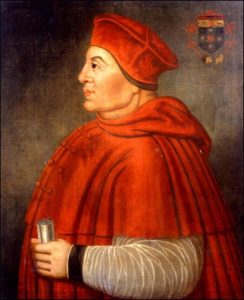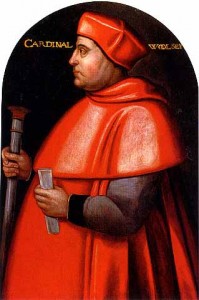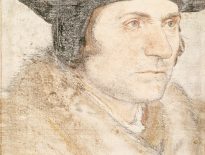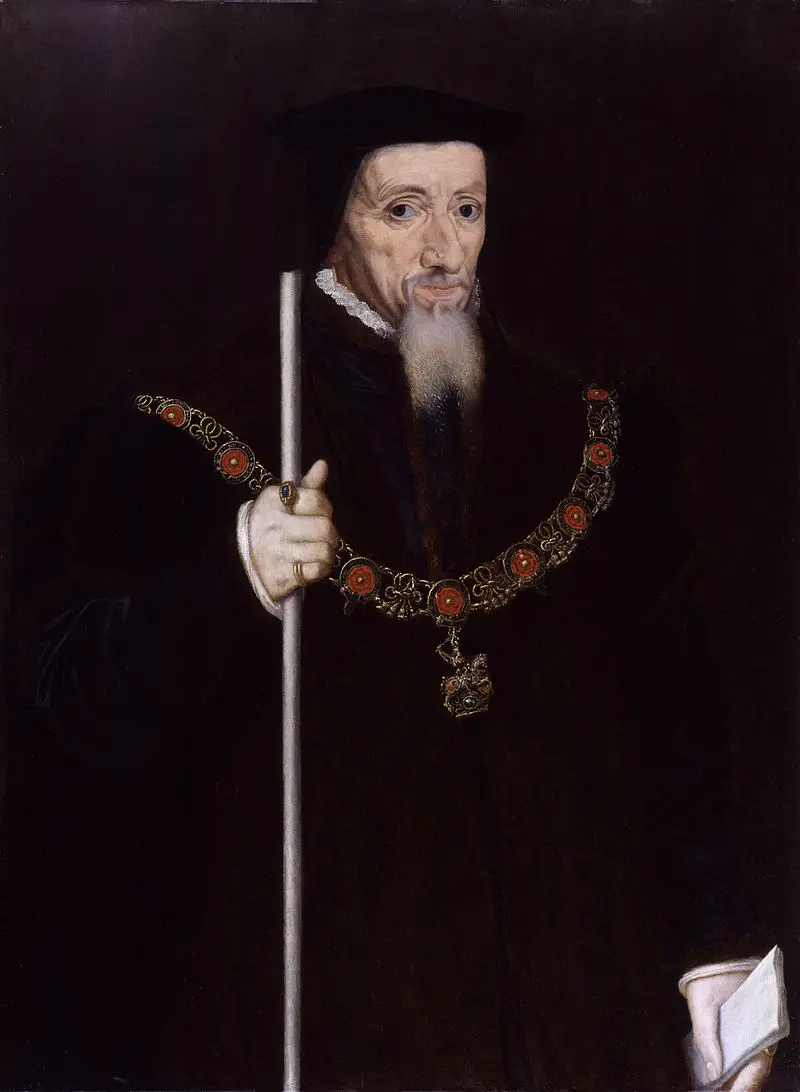 Thomas Wolsey was born between 1470 and 1473 in Ipswich, Suffolk. He was the son of Robert and Joan Wolsey. Robert owned a tavern in the parish of St. Mary at the Elms in Ipswich. Traditionally, Wolsey’s father has been identified as a butcher and cattle dealer. Thomas Wolsey’s humble origins proved a source of mirth to his critics during his long career. During his childhood and adolescence, Wolsey attended school in Ipswich and later studied at Magdalen College, Oxford, graduating with BA in 1486 when he was about fifteen years old. A decade later, he was ordained as a priest in the parish church of St. Peter in Marlborough. The year before, he graduated with MA. For a short period, Wolsey served as master of Magdalen School and, later, as dean of divinity.
Thomas Wolsey was born between 1470 and 1473 in Ipswich, Suffolk. He was the son of Robert and Joan Wolsey. Robert owned a tavern in the parish of St. Mary at the Elms in Ipswich. Traditionally, Wolsey’s father has been identified as a butcher and cattle dealer. Thomas Wolsey’s humble origins proved a source of mirth to his critics during his long career. During his childhood and adolescence, Wolsey attended school in Ipswich and later studied at Magdalen College, Oxford, graduating with BA in 1486 when he was about fifteen years old. A decade later, he was ordained as a priest in the parish church of St. Peter in Marlborough. The year before, he graduated with MA. For a short period, Wolsey served as master of Magdalen School and, later, as dean of divinity.
During the first decade of the sixteenth century, Wolsey resided in the household of Henry Deane, Archbishop of Canterbury, whom he served as chaplain. Later, he served Sir Richard Nanfan, treasurer of Calais, and after Nanfan’s death in 1507 Wolsey took up the post of royal chaplain in the service of Henry VII. He became attached to Richard Fox, Bishop of Winchester, and Sir Thomas Lovell, and was recommended by them to visit Emperor Maximilian in Flanders. Wolsey visited Scotland the following spring, meeting with James IV. The following year, Wolsey was rewarded with the deanship of Lincoln Cathedral and the prebend of Welton Brinkhall. Upon Henry VIII’s accession in 1509, Wolsey was appointed royal almoner. According to George Cavendish, Wolsey’s gentleman usher, Wolsey endeavoured to attend the king daily at court, and developed a close relationship with him. Henry rewarded him with the deanship of Lincoln and Hereford, and was later made registrar of the Order of the Garter and canon of St. George’s, Windsor.
Wolsey continued to be rewarded for his loyalty and efficient service. In 1513 he was granted the deanship of York and the following year was appointed Bishop of Lincoln. That same year, he was rewarded with the archbishopric of York and was later made a cardinal. As his influence increased, his household expanded considerably. By 1519, his yearly income may have been £9,500, a higher income than those of the nobility and peerage. Wolsey’s diplomatic activities ensured that he was rewarded with the prince-bishopric of Durham in 1523.
His increasing wealth and influence enabled Wolsey to spend large sums of money on art and architecture. Cardinal College, Oxford, was founded in 1525, although it was later suppressed. In 1532, it was refounded as King Henry VIII’s College and, later, as Christ Church. Perhaps most famously, Hampton Court Palace was expanded during the 1510s as a sumptuous residence for a Renaissance cardinal. The palace was later granted by Wolsey to Henry VIII as a gift. Wolsey also built at Bridewell and York Place; the latter was renamed Whitehall when it was taken by the king. Along with his interest in art and architecture, Wolsey was deeply committed to the new learning and was a patron of humanists. He was concerned with ensuring that reforms were made to the church, and took steps to limit benefit of clergy, the law by which a clergyman could be tried in an ecclesiastical court under canon law, rather than in a secular court. As well as ordering visitations, several decayed monasteries were dissolved by Wolsey, perhaps anticipating Henry’s later dissolution of the monasteries and religious houses. On occasion, he interceded for the church, perhaps most notably in 1515 in the wake of the Hunne affair. Anticlerical feeling had been roused by the probable murder of the merchant Richard Hunne, and in the aftermath of a series of debates about ecclesiastical autonomy, Wolsey knelt before the king and provided his master with explanations and apologies from the clergy. Wolsey firmly believed that education could effectively aid clerical reform, and with this in mind, six lectureships were founded at the University of Oxford. At Cardinal College, Wolsey provided for daily lectures in Latin, Greek and philosophy. The importing of heretical books was forbidden, and Lutheran books were publicly burned in London.
Alongside his ecclesiastical duties, Wolsey took a keen interest in maintaining law and justice. He maintained moderation in his court of chancery, and was reported to hear the suits of the poor in Star Chamber. The overflow of cases at Star Chamber meant that Wolsey was required to establish a number of temporary tribunals and, later, a judicial committee. The cardinal soon enjoyed a reputation for confronting perjury and disorder, alongside his concern to remedy injustice. In financial matters, he was active in seeking grants from the House of Commons to finance war. In 1524, the ‘Amicable Grant’, a non-parliamentary tax assessed at between 5 and 16 percent for the laity and between 25 and 33 percent for the clergy provoked revolt. The government was forced to withdraw when ten thousand gathered in protest at Lavenham, Suffolk.
In diplomacy and foreign affairs, Wolsey occupied a central role. He organised the preparations for war against France in 1513 and, when a policy of peace with France was pursued, he was involved in the marriage negotiations between Henry’s sister Mary and Louis XII of France. When the French king died, and Mary clandestinely married Charles Brandon, Wolsey provided the couple with assistance. Later, an alliance with the Habsburgs was established, but the birth of the dauphin in 1518 meant that peace negotiations were pursued with France. Henry’s daughter, Mary, was later betrothed to the dauphin. Seeking to maintain good relations with both the French and the Habsburgs, Wolsey and the king entertained Emperor Charles in 1520, and shortly afterwards Henry and his entourage met with Francois I of France and his court at the Field of Cloth of a Gold, a spectacular – if superficial – demonstration of peace and goodwill between England and France. Wolsey played an important role in the organisation of the summit, which was attended by both kings and their consorts. Despite the outward display of Anglo-French amity at the summit, an offensive alliance with the Emperor against France was pursued shortly afterwards, and a treaty was concluded in August 1522 that committed England to declaring war on France the following spring, for which Wolsey would be rewarded with an annual pension. As it transpired, war was declared on France on 29 May 1522, and the Emperor visited England that summer, prompting treaties that provided for further attacks on France. However, the Emperor reneged on his promises and negotiations were secretly concluded with the French, although it remained vital that England maintain an outward show of friendship with the Habsburgs. The Treaty of the More was signed with the French in 1525, and an anti-imperial league was formed the following year.
 In 1527, however, Wolsey’s career became complicated by what became known as the King’s Great Matter. Concerned about the future of his dynasty, Henry VIII sought to annul his marriage to Katherine of Aragon and replace her with Anne Boleyn, the queen’s attendant. According to Cavendish, the cardinal knelt before his master and begged him not to pursue the matter further. When Henry made it clear that he would have an annulment, Wolsey considered the possibility of a French marital alliance, perhaps sealed with Henry’s union with Renée of France. Wolsey’s concern to maintain peace with France was further demonstrated in his meeting with French envoys at Westminster, where he attempted to arrange the marriage of the king’s daughter Mary to Francois’ son or, even, to Francois himself. Wolsey’s involvement in the King’s Great Matter, unwilling at first, was later magnified by his critics, including Katherine of Aragon. He later travelled to the Continent in a bid to consolidate the Anglo-French peace and also sought to attain the pope’s delegation of authority to Wolsey, in order to bring the Great Matter to a favourable conclusion. Wolsey later warned the pope that, if he did not co-operate, Henry would turn against both the papacy and the church. In the summer of 1528, Cardinal Campeggio arrived in London. Campeggio’s assistance was limited and attempts to persuade Katherine to retire to a nunnery failed. Extant correspondence reveals that Campeggio had been instructed by the pope to destroy the legatine commission and fail to deliver a judgement on the marriage. Traditionally, it has been claimed that the Boleyns and their allies were working against Wolsey at this time in a bid to oust him from power, but historians have recently questioned the extent of their hostility to Wolsey. Anne Boleyn, in particular, maintained friendly and co-operative relations with the cardinal, at least to begin with, but by the end of his life, she had come to regard him as ineffectual and unlikely to secure the much-desired annulment.
In 1527, however, Wolsey’s career became complicated by what became known as the King’s Great Matter. Concerned about the future of his dynasty, Henry VIII sought to annul his marriage to Katherine of Aragon and replace her with Anne Boleyn, the queen’s attendant. According to Cavendish, the cardinal knelt before his master and begged him not to pursue the matter further. When Henry made it clear that he would have an annulment, Wolsey considered the possibility of a French marital alliance, perhaps sealed with Henry’s union with Renée of France. Wolsey’s concern to maintain peace with France was further demonstrated in his meeting with French envoys at Westminster, where he attempted to arrange the marriage of the king’s daughter Mary to Francois’ son or, even, to Francois himself. Wolsey’s involvement in the King’s Great Matter, unwilling at first, was later magnified by his critics, including Katherine of Aragon. He later travelled to the Continent in a bid to consolidate the Anglo-French peace and also sought to attain the pope’s delegation of authority to Wolsey, in order to bring the Great Matter to a favourable conclusion. Wolsey later warned the pope that, if he did not co-operate, Henry would turn against both the papacy and the church. In the summer of 1528, Cardinal Campeggio arrived in London. Campeggio’s assistance was limited and attempts to persuade Katherine to retire to a nunnery failed. Extant correspondence reveals that Campeggio had been instructed by the pope to destroy the legatine commission and fail to deliver a judgement on the marriage. Traditionally, it has been claimed that the Boleyns and their allies were working against Wolsey at this time in a bid to oust him from power, but historians have recently questioned the extent of their hostility to Wolsey. Anne Boleyn, in particular, maintained friendly and co-operative relations with the cardinal, at least to begin with, but by the end of his life, she had come to regard him as ineffectual and unlikely to secure the much-desired annulment.
As the Great Matter drew on, Wolsey’s unpopularity increased. He was blamed by Katherine and her supporters for the attempt to annul the royal marriage, and the queen accused him of tyranny, pride, vainglory, treachery, lechery and deceit. After the failure of the Blackfriars court in 1529, a book was presented to the king vouching for the pride, covetousness and dissimulation of the cardinal. Anne Boleyn also believed that he was concerned with stalling, or even preventing, the proceedings. In October that year, Wolsey was indicted for praemunire (the crime of asserting, or maintaining, papal jurisdiction in England) and was compelled to surrender the great seal and his property. The king, however, was lenient in his treatment. Wolsey was presented with a ring and a message of Henry’s good intentions towards him. In February 1530, he was pardoned and restored to the archbishopric of York, although he was ordered to surrender the see of Winchester and the abbacy of St. Albans. He later departed for the diocese of York, where he was visited by members of the gentry and attended to his duties. However, rumours of his alleged treasonous activities, including correspondence with foreign powers about the Great Matter, led to his arrest on 4th November 1530 at his home of Cawood Castle. It was intended that Wolsey would be incarcerated at the Tower of London, but he fell ill and died en route, at Leicester Abbey on 29th November 1530. He was laid to rest at the abbey.
Written by Conor Byrne.



Very interesting career. I do have a book on Thomas Wolsey and although I have not read it cover to cover it is still an interesting reference book. Is it known where in the Abbey Church Wolsey was buried? and what happened to his burial spot after the dissolution of the Abbey?